
As the longest-running soap opera of all time, The Guiding Light has had a wide variety of different logo images and theme songs. This show has always sought to redefine itself for each new generation of viewers. Earlier Guiding Light logos stressed the religious aspect, while more recent ones were more secular and emphasized romance, excitement, and pleasure.
Part One: The Early Television Years
During its first fifteen years on CBS Television, The Guiding Light used as its theme music an adaptation of "Romance from Wieniawski's Violin Concerto # 2 in D Minor." This theme music accompanied a number of different logo images.
- The very earliest GL television episodes featured a drawing of a lighthouse as an announcer said, "The new Duz brings you The Guiding Light."
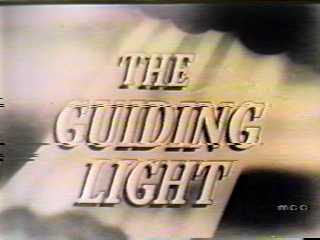 By early
1953, GL was using an opening and closing image of sunlight bursting through
the clouds.
By early
1953, GL was using an opening and closing image of sunlight bursting through
the clouds.
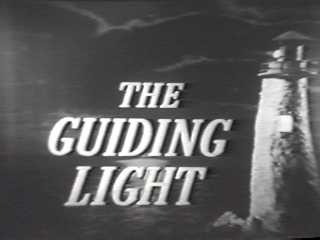 Another
lighthouse opening visual, now set on a seashore at night, was being used
by 1955. End credits during those years were set in Futura Bold type on
the left side of the screen next to the lighthouse.
Another
lighthouse opening visual, now set on a seashore at night, was being used
by 1955. End credits during those years were set in Futura Bold type on
the left side of the screen next to the lighthouse.
 The
longest-running opening logo of these early years was the title of the
show in bold Clarendon style type superimposed over a spotlight beam. This
image was used from around 1956 until probably March 10, 1967. I believe
Hal Simms may have been GL's announcer during the run of this opening.
The
longest-running opening logo of these early years was the title of the
show in bold Clarendon style type superimposed over a spotlight beam. This
image was used from around 1956 until probably March 10, 1967. I believe
Hal Simms may have been GL's announcer during the run of this opening.
Even though the following image was probably never used as an on-air logo, it is an example of the advertising used in newspapers and magazines to promote Guiding Light in the early years:

Part Two: The Guiding Light in Color
 The Guiding Light changed its opening
logo and theme music when it went from black and white to color on Monday,
March 13, 1967. The new theme music was an original composition by the then new
organist for the show, John Gart. From March 1967 to September 1968, according
to soap opera historian John Kelly Genovese, GL opened with a shot of a major
character posed in the mood of that day's episode. One fan of GL e-mailed me with the following memories of
the 1967/68 opening:
The Guiding Light changed its opening
logo and theme music when it went from black and white to color on Monday,
March 13, 1967. The new theme music was an original composition by the then new
organist for the show, John Gart. From March 1967 to September 1968, according
to soap opera historian John Kelly Genovese, GL opened with a shot of a major
character posed in the mood of that day's episode. One fan of GL e-mailed me with the following memories of
the 1967/68 opening:
. . .The program opened on a close-up of one of the character's faces against a black background. . .the announcer proclaimed the title, and the music swelled, as the camera remained fixed in a very tight shot of an actor or actress' face (normally with a very intense expression--I particularly recall Ed Bauer), after which the title was superimposed.
Also, the title of the show appeared in small cursive lettering in the lower right corner of the screen.
The Gart theme may have been, in its long version, a waltz tune in F-major, according to my recent correspondence with soap opera historian John Kelly Genovese. Closing credits in the 1967/68 season were accompanied by a shot of a lighthouse beacon.
Starting in September 1968, GL's end credits were presented in a long crawl. Also, during the 1960s, GL's top four principal cast members (Charita Bauer as Bert; Theo Goetz as Papa Bauer; Ed Bryce as Bill Bauer; and Bernard Grant as Dr. Paul Fletcher) alternated in the first billing position.
I still need to confirm facts about GL’s opening visuals from September 1968 through early 1970. The opening for that period may have been a lighthouse visual different from both the 1970-1974 version and the 1974/75 version.
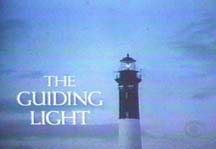 Part Three: The Early 1970s
Part Three: The Early 1970s
From around Monday, January 5, 1970 until early 1974, The Guiding Light opened with a new color lighthouse shot. According to Mr. Genovese, "The title was in smallish, simple caps at the left of the screen.” Also, the nighttime sky had a bluish hue. This visual was accompanied by a new theme in F# Major called "La Lumière" by Charles Paul, who became GL's organist in the summer of 1969. This theme, originally played on the organ, was updated in early 1974 in a recorded orchestral arrangement.
At the time of the switch to a pre-recorded orchestral arrangement of “La Lumière,” the lettering of the show's title changed to a pseudo script font as part of an entirely new lighthouse at night visual. The 1974/75 lighthouse’s visual sky backdrop had a red-orange hue.
Mid program breaks were accompanied by a short Charles Paul composition
titled "Rue D'Or," which is French for "street of gold."
(By the way, "Rue D'Or" was also, in a slightly different
arrangement, the theme for the character Peggy.) Over the long crawl end
credits, "Rue D'Or" was used in medley with "La 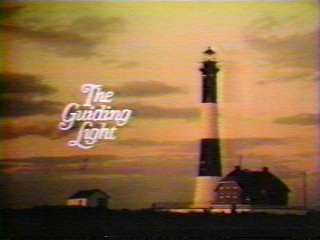 Lumière,"
with "Rue D'Or" serving as a middle section.
Lumière,"
with "Rue D'Or" serving as a middle section.
By the time the "La Lumière" opening debuted, Alan Berns had become The Guiding Light's announcer, a position he would hold until the spring of 1997.
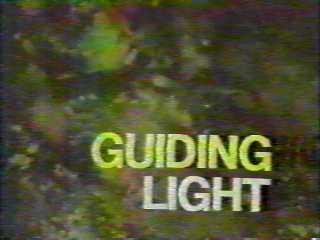 Part
Four: The Late 1970s
Part
Four: The Late 1970s
The premiere of The Young and the Restless in 1973 and the popularity of its theme music resulted in a daytime revolution. Several soaps changed their openings between the Fall of 1973 and the summer of 1976 in an attempt to incorporate easy listening pop ballad theme songs. The Guiding Light was no exception.
On November 5, 1975, a new theme song by Charles (or Dina) Paul debuted. The theme was titled "Ritournelle," which is French for "harping on the same tune," and the original version had a wordless vocal chant by a female voice over a repeated harp figure. The accompanying visual was a shot of sunlit flowers and tree branches and the words "GUIDING LIGHT" set in modern Helvetica Bold type and positioned in the lower right-hand corner of the screen.
By the beginning of 1977, the female voice chant was replaced by a high semi-muted violin rendition of the theme melody. This beautiful "harp and strings" rendition of "Ritournelle" would run until the end of 1981.
From 1976 to 1980, the end credits ran over a shot of the sunlit flowers and leaves from the opening. The 1980/81 season closing sequences featured a shot of an Emmy statuette slowly revolving on a turntable against a black background. The end credits were set in Helvetica Bold with the credit in gold and the name of the cast member/production staffer in white. By the late 1970s, GL's long crawl cast list would always begin with senior cast member Charita Bauer (Bert), usually followed by Millette Alexander (Sara) and Don Stewart (Mike) in precisely that order. Also, I get the impression that before 1982 the rest of the GL cast was billed in order of seniority.
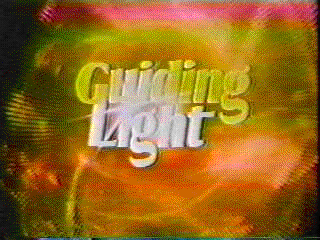 Part
Five: The 1980s Overhaul
Part
Five: The 1980s Overhaul
In the fall of 1981, Procter and Gamble decided to change the openings on most of its soaps to make them more competitive with the dominant ABC soaps and to update their visual look. As part of the change, Guiding Light briefly went disco.
A new splashy disco-style theme by Jack Urbont now accompanied a main title that started with a burst of light from the middle of some round, amber-colored abstract glass sculpture. What followed was a parade of clips from the show featuring action-packed scenes and close-ups and two-shots of all the main characters. The sequence ended with a return to that abstract light sculpture as the title of the show came up in gold and white metallic wedge-like italic letters.
The end credits, which were now set against a revolving abstract glass sculpture with twinkling lights, remained in the same gold and white Helvetica Bold setup as before. However, except for three main cast members (Charita Bauer, Millette Alexander and Don Stewart), the cast was now billed in alphabetical order. The strict ABC order setup for the cast credits remains in effect to this day.
The short-lived Urbont theme and its accompanying opening and closing visuals debuted by no later than January 4, 1982.
When Gail Kobe took over as Guiding Light's executive producer in March of 1983, she quickly instituted a more sweeping overhaul that included new cue music by Elliot Lawrence Productions and a new theme song.
The new theme, "My Guiding Light" by Rob Mounsey, was originally done in a full-orchestral Eb major arrangement. This new theme debuted on August 22, 1983, after a run of only about 400 episodes for the Urbont theme!
While the basic look of the opening montage and closing end credit visuals remained the same, there were changes such as slower transitions from one clip to another in the opening cast montage and a thinner form of Helvetica type for the end credits.
From the fall of 1985 to the October 1986, a synthesized C Major arrangement of "My Guiding Light" was used over the opening, and different arrangements of the theme were used over an end credit "beauty shot." (The end credit beauty shot lasted until the spring of 1986, when Joseph Willmore took over as executive producer.)
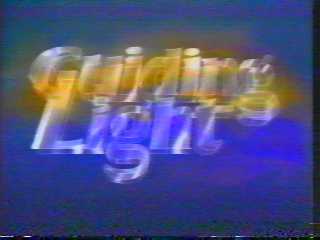 Part
Six: The Fiftieth Anniversary and the Late-1980s
Part
Six: The Fiftieth Anniversary and the Late-1980s
In October 1986, a high tech dance arrangement of "My Guiding Light" debuted over a new opening visual, which had the by-then familiar cast montage and the title of the show, in the same lettering design as that introduced in 1981/82, now set in a clear transparent glasslike sculpture against a blue sky background. The dance arrangement of "My Guiding Light" lasted until the summer of 1989, when it was replaced by a musical setting similar to 1985/86.
From October 1986 to the summer of 1989, the end credits were set against a white background, but they were now in black and gold Korinna semibold lettering. Then the format changed to gold and white Korinna semibold letters against the same blue-sky background as the main logo.
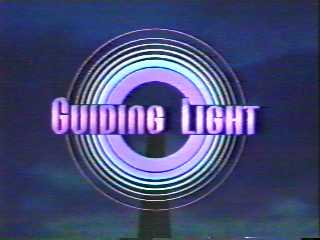 Part
Seven: The 1990s
Part
Seven: The 1990s
On January 2, 1991, Guiding Light changed to the first version of its current opening. The new sequence begins with a lighthouse whipping its beacon light around and around rather quickly. Each time the light beam comes around, we see an abstract circular light pattern that ultimately frames the title of the show in modernized silvery letters. The cast montage of this opening had a unique Knots Landing-style setup in that clips of the characters were contained inside rounded patterns that progressed from right to left across the screen, followed by the words of the title.
The new theme was "Hold On To Love" by Rob Mounsey, and the opening arrangements were in Bb Major. The slower closing version begins in A Major. After Michael D. Laibson became GL's executive producer in May 1995, he put in an island-flavored saxophone-dominated version of "Hold On To Love." This version lasted only about a month before being replaced by an electric guitar version that would open the show until early March 1997.
From 1991 to Early 1997, the end credits ran over a series of headshots of each contract player. The end credits remained in the Korinna semibold style.
In early March 1997, the full montage version of the Guiding Light 1991 opening was done away with in favor of a very short version with just the title and the lighthouse.
Part Seven: Fifty Years on Television
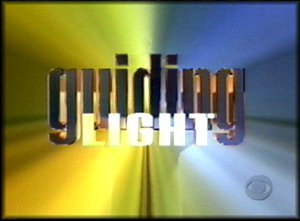 Guiding
Light unveiled a new opening logo and theme song on June 24, 2002 (June 25
in New York City Area). The new main title sequence was created by Wayne
Fitzgerald and his son and incorporated several familiar elements from the long
version of the 1991-2002 opening. Brian D. Siewart composed this theme music.
Guiding
Light unveiled a new opening logo and theme song on June 24, 2002 (June 25
in New York City Area). The new main title sequence was created by Wayne
Fitzgerald and his son and incorporated several familiar elements from the long
version of the 1991-2002 opening. Brian D. Siewart composed this theme music.
With the June 24, 2002 debut of the new opening came the end of GL’s five-year old practice of running a brief scene between the main title sequence and the first commercial break. (ATWT ceased this practice in the summer of 2001.)
Part Eight: “Guiding Light” 2003
GL changed executive producers near the end of 2002, as John Conboy replaced Paul Rauch. New producer Conboy considered sprucing up his new show’s opening a priority. Thus on February 24, 2003 (February 25 in New York and other “day behind” markets), a new opening debuted featuring clips from the show moving across the screen from right to left with the title of the show superimposed in all capital letters. The title of the show appears in a font similar to this:
GUIDING LIGHT.
In an interesting twist, the new main title sequence ends with the first scene of that day’s episode.
The new opening theme music was composed by Rick Rhodes and Danny Pelfrey and is titled “True Light.”
Here is a list of Guiding Light's theme songs:
- Variations on
"Romance" from Wieniawski's Violin Concerto # 2 in D Minor
Published Sheet Music:
Approximate run: June 2, 1947, when GL first premiered on CBS Radio, to March 10, 1967. - "The Guiding
Light"
(a.k.a. "Guiding Light Opening/Closing Theme")
Composer: John Gart (ASCAP)
Publisher: Emil Ascher, Inc. (ASCAP)
Copyright Date: May 26, 1969 (EU 121503)
Approximate run: March 13, 1967 to early 1970, or roughly episodes 4987 through 5708. According to Craig W. Pattillo's TV Theme Song Soundtrack Directory, this was GL's theme during its 18th season.
ASCAP Surveyed dates of usage: First used in the first quarter (January-March) of 1967
Published Sheet Music:
Recordings: None - "La Lumière"
Composer: Charles F. Paul (ASCAP)
Publisher: Dore Music Company (ASCAP)
East 86th Street - #15A
New York, NY 10028
Copyright date: There's no copyright record for "La Lumière." However, "La Lanterne" was registered with the Copyright Office on March 17, 1975 (EU563527).
ASCAP surveyed performance dates: First Quarter (Jan.-March) 1970 to Fourth Quarter (Oct.-Dec.) 1975.
Approximate Dates of Usage: According to Craig W. Pattillo, this was GL's theme during its 19th through 24th seasons. My guess is that "La Lumière" debuted on January 5, 1970 and was last used on November 4, 1975. (The latter finish date has been confirmed.)
Published Sheet Music:
Recordings:
- LP: "Original
Themes from the Great Soap Operas"
Charles Paul
Realm Records (A Division of Columbia House) 2V-8056 (1977)
- "Rue D'Or"
Composer: Charles F. Paul (ASCAP)
Publisher: Dore Music Company
East 86th Street - #15A
New York, NY 10028
Copyright Date: January 6, 1971 (EU 226487)
Approximate dates of usage: 1970 to 1975. (According to Craig W. Pattillo, this was GL's closing theme during its 19th through 21st seasons.)
According to Mr. David Jackson Shields of the Classic Television Themes web page, "Rue D'Or" was a GL subtheme used for the mid-program station break and as the middle portion of "La Lumière."
Recordings: Same as entry 3 above. - "Ritournelle"
Composer: Charles Paul (ASCAP) or Dina Dore Paul (BMI)
Publisher: Mi-Voix Music (BMI)
Contact Phone: (203) 868-2675
Contact Address: Mi-Voix Music Inc
c/o Dina D Paul
Box 148
Washington, CT 06793
Copyright Date: unknown
Start Date: November 5, 1975
Last Theme Air Date: December 1981 (probably episode #8804)
Approximate dates of usage: According to Craig W. Pattillo, "Ritournelle" was GL's theme during its 25th through 31st seasons. There is no other source for this title by the Pauls in either the BMI or ASCAP on-line databases.
Published Sheet Music:
Recordings:
- LP: "Original
Themes from the Great Soap Operas"
Charles Paul
Realm Records (A Division of Columbia House) 2V-8056 (1977) - LP: "Great Love
Themes from Daytime Television"
D'Arneill Pershing
Nova LPS-00001 (1978 UK release) - LP: "Soap Opera
Favorites"
D'Arneill Pershing
Sine Qua Non SQN-5053 (1986)
This is a 1986 US release of a 1978 UK album.
- "Guided
Lightning" (a.k.a. "I Remember")
Composer: Jack Urbont (BMI)
Publisher: Projagam Music
c/o URBONT MUSIC (BMI)
Contact Address: Jack Urbont Associates Inc
Urbont Music
c/o Jack Urbont
330 W 72nd St.
New York, NY 10023-2641
Copyright Date: 1982, but I've found no record for this title in the Copyright Office database.
Dates of Usage: circa January 4, 1982 (episode #8805) to August 19, 1983 (episode #9223).
Published Sheet Music:
Recordings: None - "My Guiding
Light"
(a.k.a. "The Guiding Light Theme")
Composer: Rob Mounsey (ASCAP)
Publisher: Fountain Square Music (ASCAP)
c/o Signature Sound Inc.
West 23rd Street, Suite 902
New York, NY 10010
Copyright Date: 1985, based on published sheet music.
Dates of Usage: August 22, 1983 (episode #9224) to December 28, 1990 (episode #11,067).
Published Sheet Music:
Recordings:
- LP: "Your
Favorite Soap Opera Themes"
MMR Productions. MMRP-2200 (1986) - CD: "Themes of
Our Lives"
Hollywood TV Pops
Intersound PCD-510 (1990)
Re-released in 1991 on CD as "Hits of the Soaps" on First Choice FC-4522
- "Hold On To
Love"
Composer: Rob Mounsey (ASCAP)
Publisher: Fountain Square Music (ASCAP)
c/o Signature Sound Inc.
West 23rd Street, Suite 902
New York, NY 10010
Copyright Date: 1991
Dates of Usage: January 2, 1991 (episode #11,068) to June 21, 2002.
Published Sheet Music:
Recordings:
- CD: "TV Soap
Opera Themes"
Laserlight 12-229 (1993)
For more information about the career and music of GL theme composer Rob
Mounsey, visit the Flying Monkey
Productions website at http://www.flyingmonkey.com/.
Here are a few Guiding Light links you can visit:
Guiding Light Online Community at http://www.anybrowser.org/soaps/gl/
Guiding Light News and Previews at http://soap-news.com/gl/
Sentieri—GL Website at http://www.toby-web.com/
You may also want to check out http://www.guidinglightsoundtrack.com/, which is the official site for information about Guiding Light’s music.